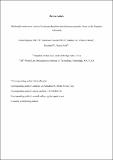Multimodal wrist-worn devices for seizure detection and advancing research: Focus on the Empatica wristbands
Author(s)
Regalia, Giulia; Onorati, Francesco; Lai, Matteo; Caborni, Chiara; Picard, Rosalind W.
Downloadmanuscript_Epilepsy_Research_revised.pdf (710.3Kb)
Publisher with Creative Commons License
Publisher with Creative Commons License
Creative Commons Attribution
Terms of use
Metadata
Show full item recordAbstract
Wearable automated seizure detection devices offer a high potential to improve seizure management, through continuous ambulatory monitoring, accurate seizure counts, and real-time alerts for prompt intervention. More importantly, these devices can be a life-saving help for people with a higher risk of sudden unexpected death in epilepsy (SUDEP), especially in case of generalized tonic-clonic seizures (GTCS). The Embrace and E4 wristbands (Empatica) are the first commercially available multimodal wristbands that were designed to sense the physiological hallmarks of ongoing GTCS: while Embrace only embeds a machine learning-based detection algorithm, both E4 and Embrace devices are equipped with motion (accelerometers, ACC) and electrodermal activity (EDA) sensors and both the devices received medical clearance (E4 from EU CE, Embrace from EU CE and US FDA). The aim of this contribution is to provide updated evidence of the effectiveness of GTCS detection and monitoring relying on the combination of ACM and EDA sensors.
A machine learning algorithm able to recognize ACC and EDA signatures of GTCS-like events has been developed on E4 data, labeled using gold-standard video-EEG examined by epileptologists in clinical centers, and has undergone continuous improvement. While keeping an elevated sensitivity to GTCS (92–100%), algorithm improvements and growing data availability led to lower false alarm rate (FAR) from the initial ˜2 down to 0.2–1 false alarms per day, as showed by retrospective and prospective analyses in inpatient settings. Algorithm adjustment to better discriminate real-life physical activities from GTCS, has brought the initial FAR of ˜6 on outpatient real life settings, down to values comparable to best-case clinical settings (FAR < 0.5), with comparable sensitivity. Moreover, using multimodal sensing, it has been possible not only to detect GTCS but also to quantify seizure-induced autonomic dysfunction, based on automatic features of abnormal motion and EDA. The latter biosignal correlates with the duration of post-ictal generalized EEG suppression, a biomarker observed in 100% of monitored SUDEP cases. Keywords: Epilepsy; Convulsive seizures; Wearable device; SUDEP; Electrodermal activity; Machine learning
Date issued
2019-02Department
Massachusetts Institute of Technology. Media LaboratoryJournal
Epilepsy Research
Publisher
Elsevier BV
Citation
Regalia, Giulia et al. "Multimodal wrist-worn devices for seizure detection and advancing research: Focus on the Empatica wristbands." Epilepsy Research 153 (July 2019): 79-82 © 2019 Elsevier
Version: Author's final manuscript
ISSN
0920-1211